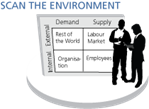 Environment Scanning is a crucial activity for Strategic Workforce Planning, and in the "external supply" quadrant, educational trends feature strongly for many organizations. Peter Cappelli's latest column in Human Resource Executive Online points out some challenges in the US education market, particularly around the "Graduate Equivalency Degree" or GED, which is a qualification attained away from high school, after dropping out. Apparently 14% of all high school graduations are GED's. Cappelli says:
Environment Scanning is a crucial activity for Strategic Workforce Planning, and in the "external supply" quadrant, educational trends feature strongly for many organizations. Peter Cappelli's latest column in Human Resource Executive Online points out some challenges in the US education market, particularly around the "Graduate Equivalency Degree" or GED, which is a qualification attained away from high school, after dropping out. Apparently 14% of all high school graduations are GED's. Cappelli says:
Why does this matter? Isn't a GED, by definition, equivalent to a regular high-school degree?
The GED is earned based on a test of the knowledge one is expected to learn in high school, an "achievement" test of the kind high-school graduates may remember in the form of Advanced Placement, or AP, tests. It is a serious test in that it seems to provide an accurate assessment of high-school knowledge.
But here's the point: There are a great many things that one learns in the process of getting a regular high-school degree that are not necessarily present in a GED test.
Cappelli points out some of those issues and the impact they could have on the organization. If you are a workforce planner in an organization which employs high school graduates as a key part of your workforce, you should read the column - your environment scan should include this trend, and your workforce plan should address how you are managing the impact of it!
If it does not specifically apply to you, take this as a good case study of the impacts that external trends can have on your workforce...and be sure you are scanning the environment for trends which DO impact you, because this is not the only educational (or other) trend out there!
Post a Comment